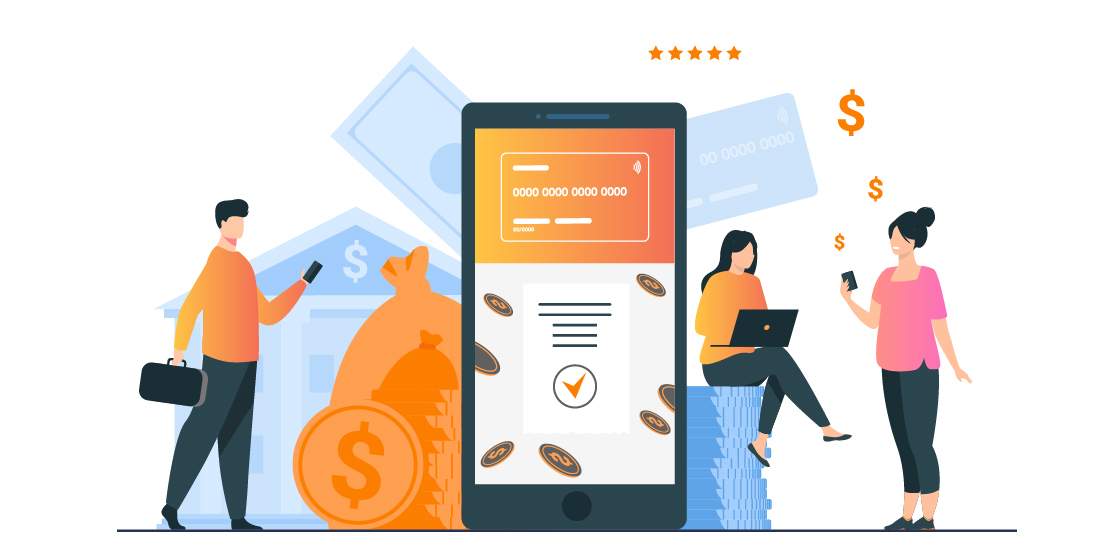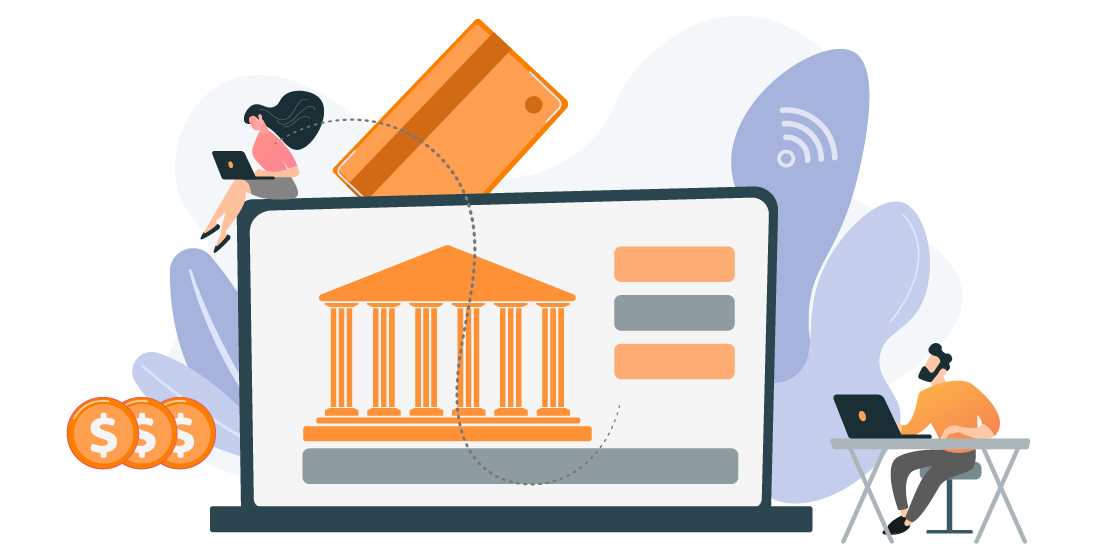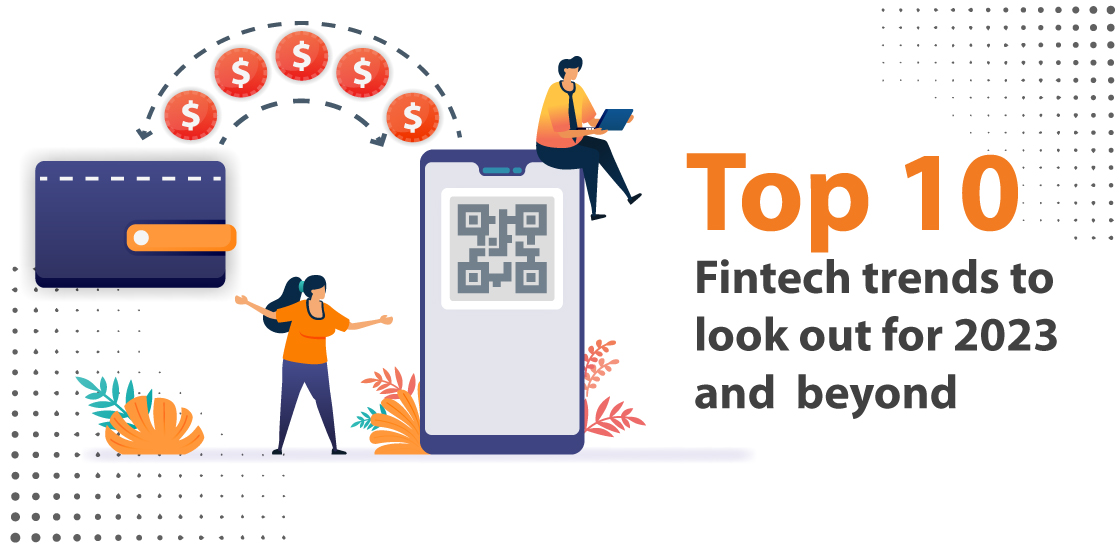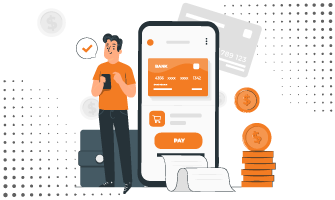Top 10 fintech trends to look out in 2023 and beyond
Financial technology, or fintech, is rapidly changing the way people manage their finances and interact with financial institutions. In recent years, fintech has grown exponentially, with new technologies and innovations emerging at a rapid pace.
Here are the top 10 fintech trends to watch in 2023 and beyond:
1. Digital Banking
- With the rise of digital banking, traditional banks are facing increased competition from fintech companies offering a range of financial services through digital platforms.
- These platforms offer a range of services, including account management, bill payments, investment management, and more.
- Thanks to these banks and financial institutions for integrating their product and service into mobile banking to offer smooth experiences to users.
- The domain will maintain its momentum in 2023 and beyond because of its low fees, convenience, and must-have quotient.
2. Cryptocurrency and Blockchain
- Cryptocurrencies like Bitcoin and Ethereum have become increasingly popular, and the use of blockchain technology is set to grow in the financial sector.
- The global blockchain market will grow 143 times before 2030 with a total volume of $1,5 trillion.
- 45% of customers already use cryptocurrencies for conducting international financial transfers, and more than half (52%) believe it to be a “legitimate option.”
- Blockchain is being used to increase transparency, security, and efficiency in financial transactions.
3. Neo Banking
- The pandemic has taught us that we can do anything from home and the fintech industry had taken that seriously.
- Neo-Banks reassemble the traditional bank and don’t have any physical location.
- Neo-Banks is equipped with all features that one traditional bank branch contains. And it’s a win-win approach because people are turning towards the neo-banks as they offer the service at a low cost with ease of access.
- The number of people with at least one account with a neo-bank is predicted to reach a peak of 39.1 million in 2025, up from 20 million in 2021, according to stats.
4. Payment Gateways

- Payment gateways establish a connection between customers and retailers to facilitate bank-to-bank transactions.
- The use of credit cards by Indian customers has grown 40x times more online, for that reason payment gateways are required for transactions.
- The market of payment gateways is increasing rapidly due to the volume of transactions increasing.
5. BNPL (Buy Now Pay Later)
- Buy Now, Pay Later is a type of short-term financing that allows for the future payment of goods or services.
- One of the most well-known BNPL systems is provided by the multinational financial business
Benefits of BNPL
No Interest: Most BNPL providers offer interest-free financing, making it an attractive option for consumers who need to make larger purchases but don’t have the cash upfront.
Convenience: BNPL allows consumers to spread out their payments over time, which can help with budgeting and managing expenses.
Fast and Easy: The application process for BNPL is usually quick and simple, with many providers offering instant approval and payment options.
-
Risks of BNPL
Late Fees: If a consumer is unable to make a payment on time, they may be subject to late fees, which can add up quickly.
Debt Accumulation: BNPL can be a slippery slope for those who struggle with managing their finances, leading to a cycle of debt and financial stress.
6. Embedded Finance
- Embedded finance denotes the integration of financial tools or services within the offerings of non-financial entities.
- It is an enormous ecosystem that includes financial services like banking, credit, investments, and as well as allied areas such as insurance and payment processing.
- Another rising segment in BNPL is where shoppers can buy products and pay for them within a few weeks in multiple equated installments.
- BNPL transactions are expected to touch “$576 billion worldwide by 2026”. This will be a big boon for B2C and B2B sectors respectively.
7. P2P Lending
- P2P lending is a way for people to lend money to other people and businesses without involving banks or other traditional financial institutions. This happens through online platforms that connect lenders and borrowers.
- People who lend money on these platforms can earn money from the interest on the loans. The loans are usually smaller than what you would get from a bank and the interest rates vary depending on the borrower’s creditworthiness.
- The platform charges fees for its services. P2P lending platforms use algorithms to assess the creditworthiness of borrowers to minimize the risk of default for lenders. Since P2P lending is not backed by a traditional system like banks, there is still some risk involved, as borrowers may default on their loans or the platform itself may face financial difficulties
- To minimize default risks for investors, P2P lending platforms typically use sophisticated algorithms to assess the creditworthiness of potential borrowers. Since P2P lending is not backed by a traditional system like banks
8. Mobile Payments
Mobile payments have undergone a significant evolution since their introduction. Starting as a basic service that allowed users to transfer money between individuals via SMS, mobile payments have become a sophisticated and convenient way to conduct financial transactions.
Here are some of the key trends that are shaping the future of mobile payments:
- Contactless payments: The COVID-19 pandemic has accelerated the shift towards contactless payments, as more consumers seek out safe and hygienic payment options. Contactless payments using mobile phones, wearables, and other devices are likely to become even more popular in the future.
- Biometric authentication: With the increasing need for security in mobile payments, biometric authentication technologies such as facial recognition, fingerprint scanning, and voice recognition are likely to become more widespread. These technologies provide an additional layer of security and convenience for mobile payment users.
- Blockchain and cryptocurrency: Blockchain-based cryptocurrencies, such as Bitcoin and Ethereum, offer a secure and decentralized way to conduct financial transactions. As the technology behind blockchain continues to evolve, we can expect to see more mobile payment platforms incorporating cryptocurrencies as a payment option.
- Integration with other technologies: Mobile payments are likely to become more integrated with other technologies, such as augmented reality, virtual reality, and artificial intelligence. These integrations could enable new and innovative ways for users to make payments and manage their finances.
- Expansion into emerging markets: With the continuing growth of mobile phone adoption in emerging markets, mobile payments are poised to become a key driver of financial inclusion in these regions. Mobile payments can provide access to financial services for people who may not have had access to traditional banking services in the past.
9. Open Banking
Open banking is a term that’s used to describe a new way of managing your money online. Basically, it means that banks and other financial companies are working together to make it easier for you to access and manage your money using different apps and websites.

Before open banking, you might have had to log in to different websites or apps for each of your bank accounts or credit cards. With open banking, you can connect all of your accounts to one app or website, so you can see all of your money in one place.
One of the coolest things about open banking is that it lets you give permission for different apps and websites to access your bank account information. This means that you can use all kinds of different apps to help you manage your money, like budgeting apps, investment apps, or even apps that help you save money on your bills.
Of course, you might be wondering if it’s safe to give all of these apps and websites access to your bank account. The good news is that open banking is designed to be very secure. All of the companies that are involved in open banking have to follow strict rules to protect your information, so you can feel safe using different apps to manage your money.
Overall, open banking is a new way of managing your money that makes it easier and more convenient to access all of your financial information in one place, and to use different apps and websites to help you manage your money better.
10. Cross-border Payments
Cross-border payments are an essential aspect of global trade, and the payment industry is experiencing significant transformations with the introduction of cryptocurrencies. Cryptocurrencies have revolutionized cross-border payments by eliminating the need for intermediaries and providing a fast, cost-effective alternative to traditional payment methods.
Traditional Cross-border Payment Methods
Before the invention of cryptocurrencies, cross-border payments were carried out using traditional payment methods such as bank transfers, wire transfers, and credit/debit card transactions. These methods involved several intermediaries which can result in slow transaction times high fees and risk of fraud.
These methods are also subject to currency conversion fees and exchange rate fluctuations which can add to the overall cost of the transaction.
Cross-border payments via cryptocurrencies
Cryptocurrencies provide a fast secure cost-effective alternative to traditional payment methods for cross-border transactions.
Unified Payments Interface (UPI)
Unified Payments Interface (UPI) is a mobile-based payment system that has been developed by the National Payments Corporation of India (NPCI). Since its launch in 2016, UPI has revolutionized the way payments are made in India.
UPI has the potential to drive globalization in several ways, including:
- Cross-border payments
- Lower transaction costs
- Increased transparency
- Increased speed
- Greater accessibility
Cross-border payments: UPI allows for easy and secure cross-border payments, which can help businesses expand their operations globally. With UPI, businesses can send and receive payments from anywhere in the world, making it easier to do business across borders.
Lower transaction costs: UPI transactions are highly cost-effective, which can reduce the transaction costs associated with cross-border payments. This can be especially beneficial for small and medium-sized enterprises (SMEs) that may not have the financial resources to bear the high costs associated with traditional payment methods
Increased transparency: UPI transactions are highly transparent, which can help build trust between parties involved in cross-border transactions. This can be especially beneficial for businesses that are new to cross-border trade and may be wary of fraudulent activities.
Increased speed: UPI transactions are completed almost instantly, which can significantly reduce the time required to complete cross-border transactions. This can help businesses respond to market changes quickly and efficiently, which is crucial for success in the global marketplace.
Greater accessibility: UPI is highly accessible, with more than 200 banks in India offering UPI services. This makes it easier for businesses to access cross-border payment services, regardless of their location or size.
Conclusion:
In conclusion, the fintech industry is rapidly changing, and these trends are set to continue in the coming years. Companies that can adapt to these changes and embrace new technologies will be best positioned to succeed in the competitive and rapidly-evolving fintech landscape.
 Keval Shah and Yash Patel
1 Mar 2023
Keval Shah and Yash Patel
1 Mar 2023
 US +1 (630) 296 6606
US +1 (630) 296 6606
 India +91 (79) 48904529
India +91 (79) 48904529
 Poland +48 (730) 059 665
Poland +48 (730) 059 665
 reach@techforceglobal.com
reach@techforceglobal.com
 +1 630 303 7389
+1 630 303 7389

 Calendly
Calendly
 LinkedIn
LinkedIn
 Whatsapp
Whatsapp
 Fintech
Fintech
 Education
Education
 Ecommerce
Ecommerce
 Healthcare
Healthcare
 Travel and Hospitality
Travel and Hospitality
 Public Sector
Public Sector




